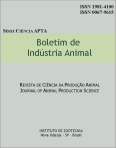Evaluation of Galactia striata (Jacq.) Urb, under two fertiization levels
Abstract
Present work was carried out at the instituto de Zootecnia in Nova Odessa, State of S5o Paulo, Brazil, from November l0th, 1980 to March l8th, 1982 and had the main objective to compare two Galactia striata ecotypes selected in the introduction field together with the commercial one. lt was evaluated the inicial stablishment, yield, persistance. quality and nutritional requirements under two levels of fertility: a without fertilization and bi with a basic fertilization acording to the soil analysis (120kg/ha of P2 O5 and 80kg/ha of K2O at the sowing time and after each cutting). The essay had the intention of release a new cultivar of Galactia striata for commercial purpouses. The local soil was a Red-Yellow Podzolic Laras variation and the experimental design was a factorial 3 x 2 with four replications. It was observed that the plant has stablished in 99 days. Fertilizing did not make significant eftect on its stablishment, persistence, weed emergence, yield and percentage of crude protein. Galactia striata cv. Yaranashowed excelent behaviour, yield and nutritiorial and sanity aspects during all the experiment. Yarana€™s CP and dry matter productions were respectively 50,87% and 50,83% of the total DM production of the other cultivars. So, the Agronomy Section decided to release it as a new cultivar for commercial use named cv. Yarana.Downloads
Downloads
Published
Issue
Section
License
Os autores não serão remunerados pela publicação de trabalhos, pois devem abrir mão de seus direitos autorais em favor deste periódico. Por outro lado, os autores ficam autorizados a publicar seus artigos, simultaneamente, em repositórios da instituição de sua origem, desde que citada a fonte da publicação original seja Boletim de Indústria Animal. A revista se reserva o direito de efetuar, nos originais, alterações de ordem normativa, ortográfica e gramatical, com vistas a manter o padrão culto da língua e a credibilidade do veículo. Respeitará, no entanto, o estilo de escrever dos autores. Alterações, correções ou sugestões de ordem conceitual serão encaminhadas aos autores, quando necessário. Nesses casos, os artigos, depois de adequados, deverão ser submetidos a nova apreciação. As opiniões emitidas pelos autores dos artigos são de sua exclusiva responsabilidade. Todo o conteúdo deste periódico, exceto onde está identificado, está licenciado sob a Licença Creative Commons Attribution (CC-BY-NC). A condição BY implica que os licenciados podem copiar, distribuir, exibir e executar a obra e fazer trabalhos derivados com base em que só se dão o autor ou licenciante os créditos na forma especificada por estes. A cláusula NC significa que os licenciados podem copiar, distribuir, exibir e executar a obra e fazer trabalhos derivados com base apenas para fins não comerciais.













